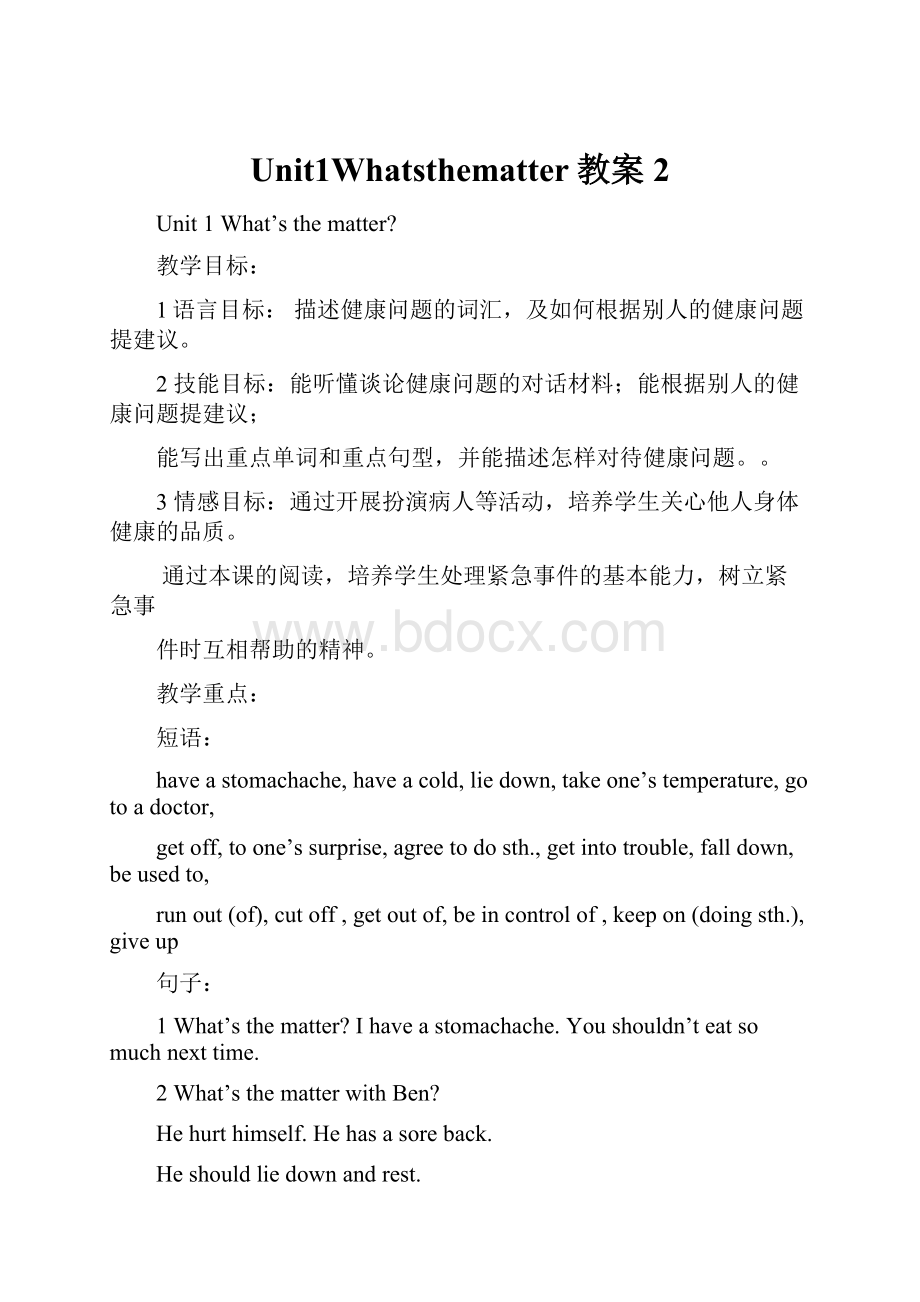Unit1Whatsthematter教案 2.docx
《Unit1Whatsthematter教案 2.docx》由会员分享,可在线阅读,更多相关《Unit1Whatsthematter教案 2.docx(34页珍藏版)》请在冰豆网上搜索。

Unit1Whatsthematter教案2
Unit1What’sthematter?
教学目标:
1语言目标:
描述健康问题的词汇,及如何根据别人的健康问题提建议。
2技能目标:
能听懂谈论健康问题的对话材料;能根据别人的健康问题提建议;
能写出重点单词和重点句型,并能描述怎样对待健康问题。
。
3情感目标:
通过开展扮演病人等活动,培养学生关心他人身体健康的品质。
通过本课的阅读,培养学生处理紧急事件的基本能力,树立紧急事
件时互相帮助的精神。
教学重点:
短语:
haveastomachache,haveacold,liedown,takeone’stemperature,gotoadoctor,
getoff,toone’ssurprise,agreetodosth.,getintotrouble,falldown,beusedto,
runout(of),cutoff,getoutof,beincontrolof,keepon(doingsth.),giveup
句子:
1What’sthematter?
Ihaveastomachache.Youshouldn’teatsomuchnexttime.
2What’sthematterwithBen?
Hehurthimself.Hehasasoreback.
Heshouldliedownandrest.
3Doyouhaveafever?
Yes,Ido.No,Idon’t.Idon’tknow.
4Doeshehaveatoothache?
Yes,hedoes.
HeshouldseeadentistandgetanX-ray.
5Whatshouldshedo?
Sheshouldtakehertemperature.
6ShouldIputsomemedicineonit?
Yes,youshouldNo,youshouldn’t.
教学难点:
掌握情态动词should \shouldn’t.的用法
学习have的用法
课时划分:
SectionA11a–2d
SectionA23a-3c
SectionA3Grammarfocus-4c
SectionB11a-2e
SectionB23a-Selfcheck
SectionA1(1a–2d)
Step1Warmingupandnewwords
1.Lookatapictureandlearnthepartsofthebody.
2.Newwordsandphrases.
Step2Presentation
1aLookatthepicture.Writethecorrectletter[a-m]foreachpartofthebody.
___arm___back___ear___eye___foot
___hand___head___leg___mouth
___neck___nose___stomach___tooth
Keys:
hegihajlcdmkf
Step3Listening
1bListenandlookatthepicture.Thennumberthenames1-5
Listentotheconversationsagainandfillintheblanks.
Conversation1
Nurse:
What’sthematter,Sarah?
Girl:
I___________.
Conversation2
Nurse:
What’sthematter,David?
Boy:
I_________________.
Conversation3
Nurse:
What’sthematter,Ben?
Boy:
I_________________.
Conversation4
Nurse:
What’sthematter,Nancy?
Girl:
I_________________.
Conversation5
Betty:
What’sthematter,Judy?
Ann:
She__________________.
Keys:
haveacold
gotastomachache
haveasoreback
haveatoothache
hasasorethroat
Step4Speaking
1cLookatthepictures.Whatarethestudents’problems?
Makeconversations.
Examples
A:
What’sthematterwithJudy?
B:
Shetalkedtoomuchyesterdayanddidn’tdrinkenoughwater.
Shehasaverysorethroatnow.
A:
What’sthematterwithSarah?
B:
Shedidn’ttakecareofherselfontheweekend.Shewasplayingwithherfriendsattheparkyesterday.Thenitgotwindy,butshedidn’tputonherjacket.Nowshehasacold.
Step5Guessinggames
Guesswhathashappenedtothestudentsbyusingtheimportantsentences.
Step6Listening
2aListenandnumberthepictures[1-5]intheorderyouhearthem.
Keys:
24315
2bListenagain.Matchtheproblemswiththeadvice.
1feveraliedownandrest
2stomachachebdrinksomehottea
3coughandsorethroatcseeadentistandgetanX-ray
4toothachedtakeyourtemperature
5cutmyselfeputsomemedicineonit
Keys:
dabce
Step7Speaking
2cMakeconversationsusingtheinformationin2aand2b
A:
What’sthematter?
B:
Myheadfeelsveryhot.
A:
Maybeyouhaveafever.
B:
WhatshouldIdo?
A:
Youshouldtakeyourtemperature.
Step8Role–play
1.Imagineyouaretheschooldoctor.Afewstudentshavehealthproblems.Role-playaconversationbetweenthedoctorandthestudents.
2dRole–playtheconversation
2.Answerthequestions.
1)What’sthematterwithLisa?
2)Didshehaveafever?
3)Whatdidshedothenightbefore?
4)Whatdoessheneedtodo?
5)Whatshouldshedofornow?
6)Whatshouldshedoifthingsdon’tgetbetter?
Keys:
Shehasaheadacheandcan’tmoveherneck.
No,shedidn’t.
Sheplayedcomputergamesallweekend.
Sheneedstotakebreaksawayfromthecomputer.
Sheshouldliedownandrest.
Sheshouldgotoadoctor.
Step9Languagepointsandsummary
1.What’sthematter?
What’sthematter?
与What’swrong?
同义,均意为“怎么了?
”,常用来询问疾病、事故伤害等。
如果表示某人怎么了,应该用What’sthematterwithsb.?
或What’swrongwithsb.?
如:
What’sthematter/What’swrongwiththeoldman?
What’sthematter?
的答语通常有以下几种:
①“sb.+have/get/catcha(n)+疾病名称”表示患某种疾病。
如:
Ihave/get/catchacold.
②“sb.+be/feel+某些形容词”表示某人感到不适。
如:
Iam/feelsick.
③“身体部位+be/feel+某些形容词”表示某部位感到不适。
如:
Myheadis/feelshot.
④“身体部位+hurt”表示某部位痛。
如:
Mystomachhurts.
⑤“sb.+get+某些动词的过去分词形式”表示受伤。
如:
Hegotsunburnedyesterday.
⑥“sb.+hurt/cut+具体部位/反身代词”表示伤害。
如:
Hehurthisarmintheaccident.
Icutmyselfwhencooking.
【链接】用来询问疾病、不适或突发情况时,还可用以下句型:
What’sthetrouble(with...)?
Whathappened(to...)?
Isthereanythingwrong(with...)?
【运用】根据括号内的要求完成下列各题。
(1)—_____________________________
_____________________________?
—Mybrotherhasacough.(写出问句)
(2)—Whathappenedtohim?
—He___________(切着自己)cuttingthetomatoes.(根据汉语提示补全答语)
2.Ihaveacold.
haveacold伤风,感冒,是固定词组
表示身体不适的常用词组还有:
haveabadcold重感冒
haveafever发烧
haveaheadache头痛
haveastomachache肚子痛,胃痛
haveatoothache牙痛
Summary
1.牙疼haveatoothache
2.胃疼haveastomachache
3.背疼haveabackache
4.头疼haveaheadache
5.喉咙疼haveasorethroat
6.发烧haveafever
7.感冒haveacold
8.躺下并且休息liedownandrest
9.喝热蜂蜜茶drinkhotteawithhoney
10.喝大量水drinklotsofwater
11.看牙医seeadentist
12.量体温takeone’stemperature
13.看医生gotoadoctor
Step10Exercises
根据上下文意思填空。
Mandy:
Lisa,areyouOK?
Lisa:
I_____aheadacheandIcan’tmovemyneck.What______Ido?
ShouldI
_____mytemperature?
Mandy:
No,itdoesn’tsoundlikeyouhaveafever.What_____youdoonthe
weekend?
Lisa:
Iplayedcomputer_____allweekend.
Mandy:
That’sprobablywhy.Youneedtotakebreaks_____fromthecomputer.
Lisa:
Yeah,IthinkIsatinthe_____wayfortoolongwithoutmoving.
Mandy:
Ithinkyoushould____downandrest.Ifyourheadandneckstillhurttomorrow,thengotoa_______.
Lisa:
OK.Thanks,Mandy.
Keys:
haveshouldtakedidgamesawaysameliedoctor
翻译下列句子。
1.你怎么了?
我头痛。
2.他怎么了?
他发烧
3.李雷怎么了?
他喉咙痛。
他应该多喝水。
4.如果你的头和脖子明天仍然疼的话,请去看医生。
Keys:
Whatisthematterwithyou?
Ihaveaheadache.
What’sthematterwithhim?
Hehasafever.
What’sthematterwithLiLei?
Hehasasorethroat.
Heshoulddrinklotsofwater.
Ifyourheadandneckstillhurttomorrow,thengotoadoctor.
Step11Homework
Makeupaconversationbetweenadoctorandapatient.
SectionA2(3a–3c)
Step1Presentation
Lookatthepicture.Discusswhathappenedandthenwhatweshoulddo.
Teacher:
Whathappenedinthepicture.
Students:
Teacher:
Whatshouldwedotohelpthem?
Students:
Step2Reading
BusDriverandPassengersSaveanOldMan
1.Lookattheheadlineandpicturethenanswerthequestions.
Whathappenedtothemanlyingbytheroad?
Whatwasthepersonnexttohimdoing?
Didthismandie?
Whodoyouthinkisgoingtosavetheman?
2.3aReadthepassageandanswerthefollowingquestions.
Doyouthinkitcomesfromanewspaperorabook?
Howdoyouknow?
Didthebusdriverhelpthemanandthewoman?
阅读指导
1)先认真阅读每个题目的意思,弄清要求我们寻找什么信息。
2)带着问题,再来读短文。
在短文中认真寻找我们所需的信息,在有相关内容的地方,应多读几次,认真理解,以找到想要找的信息。
3)最后,再通读一遍,检查一下所找的答案是否正确。
Keys:
Itcomesfromanewspaper.Ittellsusthetime,theplace,thecharacterandtheeventinthefirstparagraph.
Yes,hedid.
3.3bReadthepassageagainandcheckthethingsthathappenedinthestory.
1____WangPingwasthedriverofbusNo.26at9:
00a.m.yesterday.
2____BusNo.26hitanoldmanonZhonghuaRoad.
3____Theoldmanhadaheartproblemandneededtogotothehospitalright
away.
4____Thepassagersonthebusdidnotwanttogotothehospital,soonly
WangPingwentwiththewomanandoldman.
5____Somepassagershelpedtogettheoldmanontothebus.
6____Theoldmangottothehospitalintime.
Keys:
1356
Step3Speaking
3cDiscussthequestionswithapartner.
1.WhywasWangPingsurprisedthatthepassengersagreedtogotothehospitalwithhim?
2.DidthepassengersthinkWangPingdidtherightthing?
Howdoyouknow?
3.Doyouagreethatpeopleoftendonothelpothersbecausetheydonotwanttogetintotrouble?
Whyorwhynot?
Step4Languagespoints
1....whenthedriversawanoldmanlyingonthesideoftheroad.
......这时司机看到一位老人正躺在路边。
观察与思考:
你能看出“看到某人正在做某事”的句型吗?
seesb.doingsth.看见某人正在做某事
e.g.WhenIpassthewindowIseehimdrawingapicture.
seesb.dosth.看见某人做过某事
e.g.Ioftenseehimdrawapicture.
活学活用
1)我看见他时他正在河边玩。
Isawhim_______bytheriver.
2)我看见过他在河边玩。
Isawhim_____bytheriver.
3)我看着他过了桥。
Iseehim______acrossthebridge.
4)我看见她正在洗碗。
Iseeher_________thedishes.
Keys:
playingplaywalkwashing
2.Thebusdriver,24-year-oldWangPing,stoppedthebuswithoutthinkingtwice.
3.Heonlythoughtaboutsavingalife.
观察与思考:
你能看出“withoutthinking”、“aboutsavingalife”的共同点吗?
共同点:
介词+doing
介词+名词
宾格代词
doing
活学活用
用适当的形式填空。
1)Iamfine.Whatabout____(she)?
2)Thanksfor______(tell)methestory?
3)Itisasunnyday.Howabout_____(go)fishing?
4)Itisgoodtorelaxby______(use)theInternetor_________(watch)gameshows.
Keys:
hertellinggoingusingwatching
4.Buttohissurprise,theyallagreedtogowithhim.
toone’ssurprise使......惊讶的是,出乎......意料
e.g.Totheirsurprise,allthestudentspasstheexam.
Muchtoeveryone’ssurprise,theplansucceeded.
5....becausetheydon’twantanytrouble,...
当trouble意为“困难;麻烦”时,是不可数名词。
如:
I’msorrytogiveyousomuchtrouble.
(1)beintrouble意为“有困难;陷入困境”。
如:
Healwaysasksmeforhelpwhenheisintrouble.
(2)getsb.intotrouble意为“使某人陷入困境”。
如:
Ifyoucome,youmaygetmeintotrouble.
(3)主语+have/hastroubl